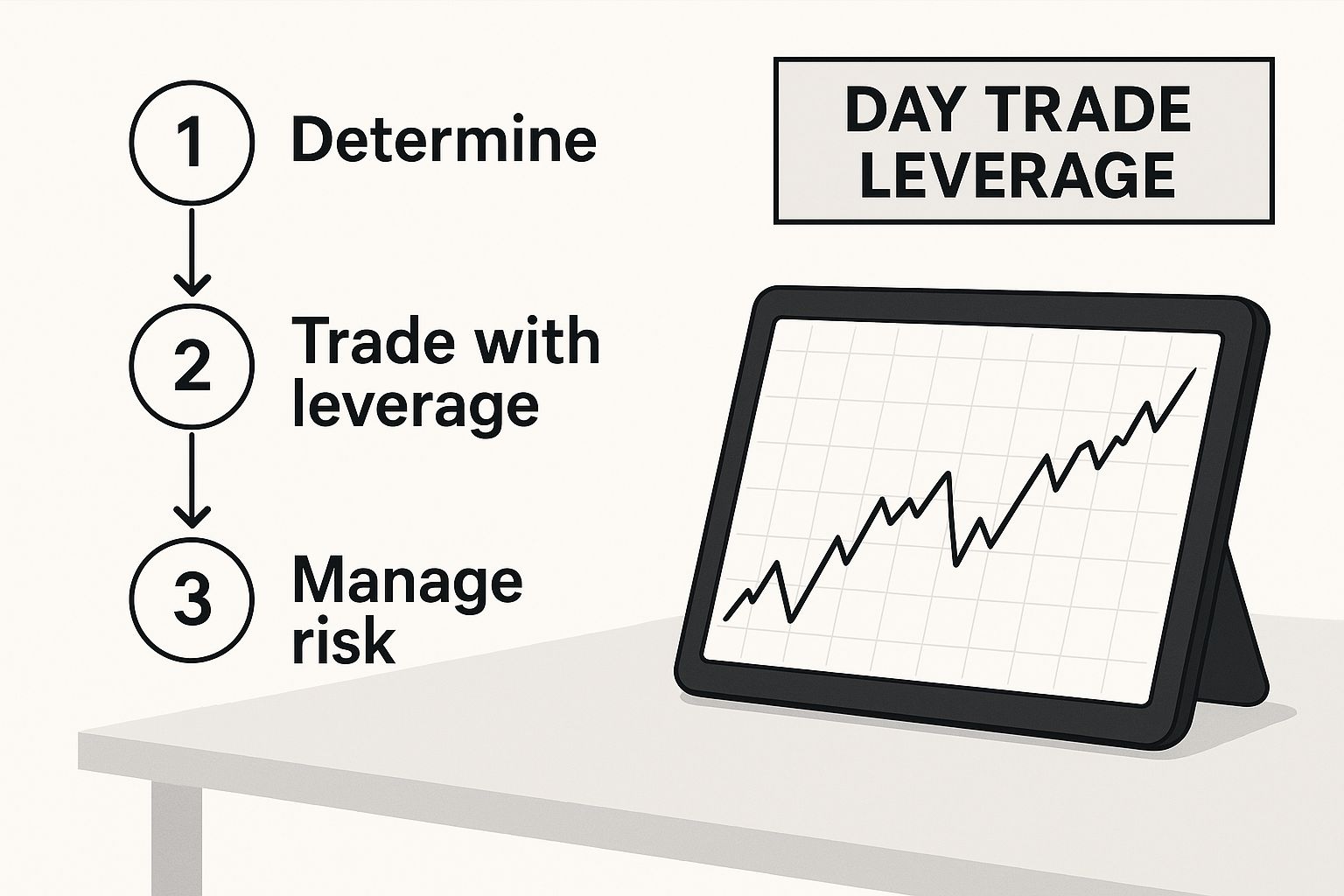Ever since we started Trading Made Easy back in 2014, our mission has been to simplify the complexities of the trading world for everyday investors. One of the biggest hurdles we see people trip over is the Pattern Day Trader (PDT) rule. It sounds intimidating, but with the right knowledge—and the right tools—it’s actually more straightforward than you might think.
Here's the gist: if you make four or more "day trades" within a five-business-day window using a margin account, your broker will flag you as a pattern day trader.
What Are the Pattern Day Trader Rules, Anyway?

First off, the PDT rule isn't here to punish you. It’s a financial safeguard, plain and simple. Think of it as a set of guardrails put in place by the Financial Industry Regulatory Authority (FINRA) to make sure traders who are highly active have enough capital to handle the heat of potential losses.
This regulation officially came on the scene back in 2001, established by the U.S. Securities and Exchange Commission (SEC). It was a direct response to the explosion of retail trading during the dot-com bubble and the risks that came with it. The main goal was to address the dangers of traders using margin to rapidly jump in and out of stocks. You can dig deeper into the origins of these regulations and see how they’ve shaped modern trading.
At its heart, the rule comes down to two simple things: what counts as a "day trade" and how often you're making them.
A day trade is just the act of buying and then selling the same stock (or other security) on the same day. It's that simple. If you buy a stock in the morning and sell it that afternoon, that’s one day trade. Buy and sell it again later that day? That's two day trades.
The Five-Day Moving Window
The rule doesn't operate on a clean Monday-to-Friday calendar week. Instead, it uses a five-business-day "moving window". This is a crucial detail. It means your broker is always looking at your activity over the most recent five trading days on a rolling basis.
Let’s say you make two day trades on Monday and another two on Wednesday. You’ve now hit four day trades within a five-day period. At that moment, your brokerage firm will label your account as a pattern day trader account.
Once you get that flag, a new set of rules kicks in. The biggest one is the minimum equity requirement, which is where that famous $25,000 threshold comes into play. We’ll break that down in just a bit.
For now, just remember that keeping an eye on your trade count within this rolling window is key to managing your account and avoiding any surprise trading restrictions.
For a quick summary, here’s a table breaking down the core parts of the PDT rule.
PDT Rule At a Glance
| Component | Definition | Requirement |
|---|---|---|
| Day Trade | Buying and then selling (or selling short and then buying to cover) the same security on the same day in a margin account. | Each buy/sell pair counts as one trade. |
| Pattern Day Trader | An account that executes four or more day trades within a five-business-day period. | The number of day trades must also be more than 6% of total trades in the account during that same period. |
| Minimum Equity | The minimum account balance required to be a pattern day trader without restrictions. | Maintain an account value of at least $25,000. |
| Penalty | The consequence for a flagged PDT account falling below the minimum equity requirement. | The account will be restricted to closing transactions only for 90 days or until the equity is restored. |
This table is a great starting point, but understanding the nuances is what will really help you navigate the markets effectively.
The $25,000 Question Unpacked

So, your account gets flagged as a pattern day trader. The very next thing you'll face is the famous $25,000 minimum equity rule. This isn't just a one-time deposit to get you in the door; think of it as a permanent financial baseline your account must maintain to keep trading freely.
This rule always stirs up a ton of questions. Does it have to be all cash? What happens if my stocks dip for a few hours and my account value drops below the line? Let's clear up the confusion.
Demystifying Account Equity
When regulators talk about "equity," they mean the total value of everything in your account—your cash plus the value of your securities like stocks and ETFs—minus any money you've borrowed from your broker. It's essentially your account's net worth at the close of business each day.
So, if you have $15,000 in cash and $15,000 worth of stock, your total equity is $30,000. You’re safely above the threshold.
The $25,000 rule isn’t about how big your trades are; it's about the total value of your account. You could be making tiny $100 trades all day, but if your account equity is below the minimum, you’ll still be restricted once you're flagged as a PDT.
Why This Minimum Exists
Regulators put this rule in place as a financial cushion. Let's be honest, active day trading, especially with borrowed money (margin), is risky. The $25,000 is there to ensure traders have enough capital to absorb potential losses without getting a nasty margin call or causing a domino effect for their broker.
This requirement is a massive part of the puzzle for anyone looking to trade seriously. If you're still working your way up to that level, getting the basics down is essential. For more on that, you can read our guide on how to start day trading to build a solid foundation.
Think of this equity floor as your key to unlocking your full day trading buying power, which is often four times your available margin. Meeting this requirement isn't just about following the rules—it gives you the firepower you need to execute your strategy without your broker slamming on the brakes. It’s your ticket to trade as often as you want.
Stay Under the Radar and Avoid the PDT Flag
If you want to trade actively but don't want the "Pattern Day Trader" (PDT) label—and the hefty $25,000 account minimum that comes with it—your best defense is awareness. It’s all about knowing your exact trade count and where you stand within that rolling five-day window.
A really simple way to do this is just to track it yourself. Think of it like a tally sheet for the week. You make one day trade on Monday. Zero on Tuesday. Then you make two more on Wednesday. At that point, your running total is three. If you place just one more day trade on Thursday or Friday, you’re going to get flagged. Keeping a simple count like this puts you in the driver's seat.
Using Built-in Brokerage Tools
Of course, you don’t have to do all the math on a napkin. Most modern brokers have built-in PDT counters that automatically watch your activity. These tools are your best friend for staying on the right side of the rules.
Take a look around your broker’s dashboard to find this feature. It usually shows you exactly how many day trades you have left before you hit that magic number of four.
The image below gives you a sense of why these rules exist in the first place. When you use leverage, the potential for big wins and big losses gets dialed way up, which is why having tracking tools is so important.

As you can see, borrowing funds can accelerate everything, and that’s a big reason FINRA put the PDT rule in place to begin with.
The Overlooked 6% Rule
Now, here’s a little-known detail that can be a real game-changer: the 6% rule. To get flagged as a PDT, your day trades don't just have to hit the "four or more" mark; they also have to make up more than 6% of your total trades in that same five-day stretch. This is a critical nuance that can be a lifesaver.
For example, let's say you made four day trades. But in that same five-day period, you also made 100 other trades that you held overnight or longer. In that case, your day trades are only 4% of your total activity (4 out of 104 trades). You wouldn't be flagged. This rule is a huge help for traders who like to mix in longer-term holds with their short-term moves.
For anyone just starting out, getting a handle on these details is what separates success from frustration. That’s exactly why our guide on day trading strategies for beginners is such a great place to start. When you understand both the trade count and this percentage rule, you’ve got the full picture and can trade with much more confidence.
Alright, let's say you've done it. You accidentally made that fourth day trade within five days, and your account is sitting below the $25,000 mark. Now what? You can't just brush it off and keep trading. The consequences are real and they kick in right away, usually starting with a notification from your broker.
https://www.youtube.com/embed/7fKm63kaJMs
You'll get what's known as a Pattern Day Trader (PDT) margin call. Think of it as an official flag on your account, letting you know you've crossed the line. Once you get this notice, the clock starts ticking. You have five business days to get your account equity up to the $25,000 minimum, either by depositing cash or hoping your existing positions gain enough value.
This happens more often than you might think. Brokerage and regulatory data suggest that a staggering 70-80% of retail traders who get flagged as pattern day traders don't manage to keep their equity above that $25,000 threshold. It’s a common pitfall for new traders, and you can find more stories about how people navigate these day trading rules and restrictions.
The 90-Day Freeze
But what if you can't come up with the funds to meet that margin call? If those five business days pass and your account is still under $25,000, your broker will restrict your account for 90 days.
This isn't just a friendly warning. It's a hard freeze on your ability to open any new trades. For the next 90 days, the only thing you'll be allowed to do is close out the positions you already have.
Anonymized Story: We know a trader who got caught in a whirlwind week of high volatility. He didn't even realize he'd made his fourth day trade until the PDT flag hit his account. He couldn't deposit the necessary funds in time, and just like that, his account was locked for 90 days. He had to sit on the sidelines and watch some incredible market opportunities go by, a painful lesson on why staying on top of your account is absolutely critical.
How to Keep Trading Without Hitting PDT Limits
So, you've run into the pattern day trader rules, but your account is under the $25,000 mark. Don't worry, this isn't a dead end for your trading ambitions. There are a few clever and perfectly legal ways to stay in the game without getting flagged. It all comes down to knowing your options and picking the one that fits how you want to trade.
One of the most straightforward paths around the PDT rule is to use a cash account instead of a margin account. It's that simple. The rule just doesn't apply, freeing you up to make as many day trades as your cash on hand allows.
Trading with a Cash Account
There is a catch, though: the settlement period. When you trade in a cash account, the money you make from selling a stock has to "settle" before you can use it again. For stocks and ETFs, the good news is this period is now just one business day (T+1), down from the old T+2 rule.
What this means in practice is if you have a $5,000 account and use it all on a day trade on Monday, that $5,000 is tied up until it settles on Tuesday. You can't touch it. This forces you to be smart about managing your cash, because you can only ever trade with settled funds.
The Swing Trading Strategy
Another great way to sidestep the PDT rule is to become a swing trader. Remember, a day trade is defined as opening and closing a position on the same day. If you just hold that position overnight, it's no longer a day trade. It won't count against your four-trade limit.
Swing trading lets you capture bigger market moves that play out over a few days or even weeks. Not only does this get you around the pattern day trader rule, but it also encourages a more patient, strategic mindset. You're no longer glued to the one-minute chart.
This approach is perfect for traders who want to stay active but don't have the time or desire to watch every tick of the market.
Trading Account Types and PDT Rule Applicability
Choosing the right account type is your first line of defense against PDT restrictions. The table below breaks down the most common options and how the PDT rule affects each one, helping you align your account with your trading strategy.
| Account Type | PDT Rule Applies? | Key Limitation | Best For |
|---|---|---|---|
| Margin Account | Yes | 4 day trades in 5 days (if under $25k) | Experienced traders who need leverage and short selling. |
| Cash Account | No | Must wait for funds to settle (T+1) | New traders or those who want to day trade without a $25k balance. |
| Retirement Account (IRA) | Usually Margin | Subject to PDT rule if margin is enabled | Long-term investing; day trading is generally not advised. |
As you can see, a simple switch to a cash account can solve the PDT problem for many traders. It forces discipline but offers freedom from the rule itself.
Exploring Other Markets
Finally, don't forget that FINRA's PDT rules are specific to stocks and options traded through U.S. brokerages. Other markets play by a completely different set of rules.
- Futures Trading: The futures market is a hugely popular alternative for active traders, especially those with smaller accounts, because it isn't subject to the PDT rule at all.
- Forex Trading: The foreign exchange market also operates independently of PDT regulations, offering another way to trade actively without restrictions.
These markets are packed with liquidity and volatility, providing plenty of opportunities for traders looking to avoid the PDT headache entirely. Ultimately, the goal is to find the path that works for you—active trading is within reach for everyone, regardless of account size.
Let Our System Handle the Heavy Lifting
Let's be honest: trying to keep track of every single trade while also navigating a volatile market is exhausting. That's why we built our automated day trading software at Trading Made Easy—to take the pressure off your shoulders so you can focus on strategy, not just compliance.
Unique Features for Smarter Trading
Our system isn't just about placing trades; it’s about executing a proven strategy with discipline. Key features include:
- Automated PDT Tracking: The software monitors your day trade count in real-time, preventing you from accidentally crossing the four-trade threshold. This eliminates the fear of getting flagged and locked out.
- Emotion-Free Execution: By automating trades based on your predefined strategy, our software removes the emotional second-guessing that leads to costly mistakes.
- Advanced Risk Management: Set custom stop-losses and profit targets that the system enforces without hesitation, protecting your capital 24/7.
These features work together to create a disciplined trading environment, allowing you to build consistency and confidence.
Success Stories: Real Results for Real Traders
We’ve seen firsthand how automation can transform a trader's journey.
- John M., a part-time trader, was constantly stressed about violating PDT rules while at his day job. Our software allowed him to stay active in the market without fear. He saw a 25% increase in his account in the first three months just by eliminating compliance-related errors and emotional trades.
- Sarah K. struggled with consistency, often closing trades too early out of fear. With our system managing her exits based on strategy, she was able to let her winners run and cut her losses short, turning her portfolio from breakeven to profitable.
Stories like these are why we do what we do. Our software empowers you to master the pattern day trader rules and trade with peace of mind.
Common Questions About Pattern Day Trader Rules
Even after you think you've got the pattern day trader rules down, some specific questions almost always come up. Let's walk through a few of the most common ones I hear to iron out any confusion so you can trade with more confidence.
Can I Get the PDT Flag Removed?
Yes, you usually can. Most brokers will offer a one-time courtesy removal of the PDT flag, but you have to ask for it. You’ll need to get in touch with their support team and make a formal request.
Just know that this is almost always a one-and-done deal. If you get flagged a second time in that same account, it's probably staying there for good.
Do the Rules Apply to Options and ETFs?
They absolutely do. The rule isn't concerned with what you're trading, but how you're trading it. A day trade is a day trade, plain and simple.
Whether you buy and sell a stock, an options contract, or an ETF within the same day, it counts. Each one ticks against your four-trade limit. It's just like how understanding the fundamentals, such as what the bid-ask spread means, is crucial for any kind of active trading.
What if My Broker Flags Me by Mistake?
It's rare, but mistakes can happen. If you’re sure you’ve been flagged incorrectly, the first thing to do is pull up your trade history. Go through it carefully, checking every trade against that five-day rolling window.
If you find a genuine error, get on the phone with your broker’s compliance department right away. Present your evidence clearly, and they should be able to get it sorted out for you.
Navigating the pattern day trader rules doesn't have to be a source of stress. The key is understanding the regulations and leveraging the right tools to maintain discipline. Since 2014, Trading Made Easy has been dedicated to building automated software that helps traders handle compliance, manage risk, and execute strategies without guesswork. We've helped traders like John and Sarah move from anxiety to confidence. You can too. Explore our automated solutions today and take the first step toward smarter, more consistent trading.


Leave a Reply